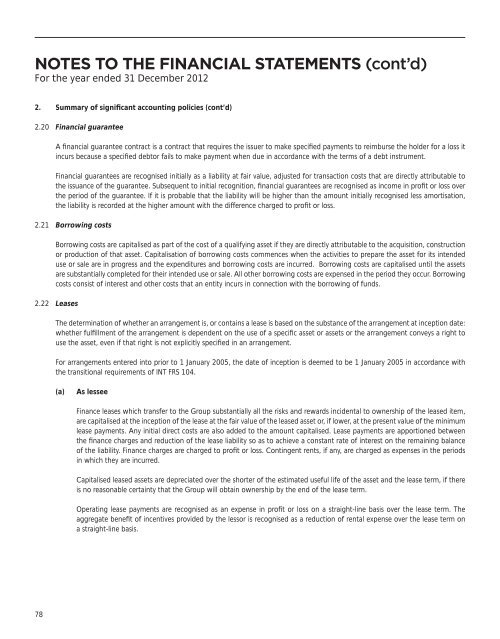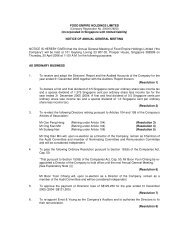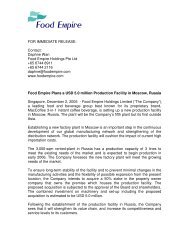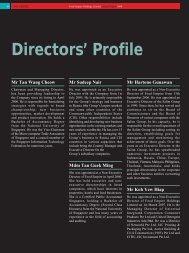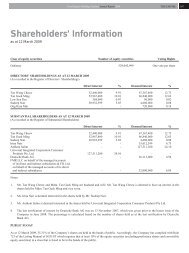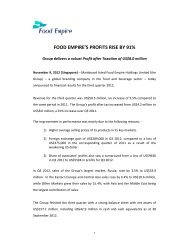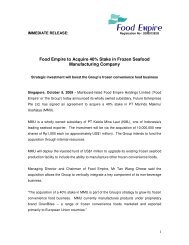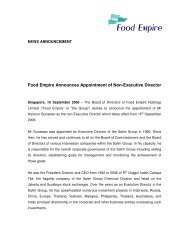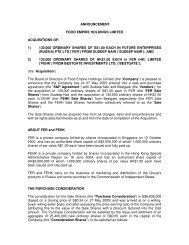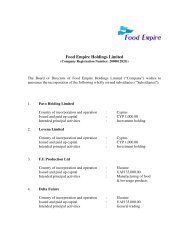notes to the financial statements - Food Empire Holdings Limited
notes to the financial statements - Food Empire Holdings Limited
notes to the financial statements - Food Empire Holdings Limited
You also want an ePaper? Increase the reach of your titles
YUMPU automatically turns print PDFs into web optimized ePapers that Google loves.
NOTES TO THE FINANCIAL STATEMENTS (cont’d)<br />
For <strong>the</strong> year ended 31 December 2012<br />
2. Summary of significant accounting policies (cont’d)<br />
2.20 Financial guarantee<br />
A <strong>financial</strong> guarantee contract is a contract that requires <strong>the</strong> issuer <strong>to</strong> make specified payments <strong>to</strong> reimburse <strong>the</strong> holder for a loss it<br />
incurs because a specified deb<strong>to</strong>r fails <strong>to</strong> make payment when due in accordance with <strong>the</strong> terms of a debt instrument.<br />
Financial guarantees are recognised initially as a liability at fair value, adjusted for transaction costs that are directly attributable <strong>to</strong><br />
<strong>the</strong> issuance of <strong>the</strong> guarantee. Subsequent <strong>to</strong> initial recognition, <strong>financial</strong> guarantees are recognised as income in profit or loss over<br />
<strong>the</strong> period of <strong>the</strong> guarantee. If it is probable that <strong>the</strong> liability will be higher than <strong>the</strong> amount initially recognised less amortisation,<br />
<strong>the</strong> liability is recorded at <strong>the</strong> higher amount with <strong>the</strong> difference charged <strong>to</strong> profit or loss.<br />
2.21 Borrowing costs<br />
Borrowing costs are capitalised as part of <strong>the</strong> cost of a qualifying asset if <strong>the</strong>y are directly attributable <strong>to</strong> <strong>the</strong> acquisition, construction<br />
or production of that asset. Capitalisation of borrowing costs commences when <strong>the</strong> activities <strong>to</strong> prepare <strong>the</strong> asset for its intended<br />
use or sale are in progress and <strong>the</strong> expenditures and borrowing costs are incurred. Borrowing costs are capitalised until <strong>the</strong> assets<br />
are substantially completed for <strong>the</strong>ir intended use or sale. All o<strong>the</strong>r borrowing costs are expensed in <strong>the</strong> period <strong>the</strong>y occur. Borrowing<br />
costs consist of interest and o<strong>the</strong>r costs that an entity incurs in connection with <strong>the</strong> borrowing of funds.<br />
2.22 Leases<br />
The determination of whe<strong>the</strong>r an arrangement is, or contains a lease is based on <strong>the</strong> substance of <strong>the</strong> arrangement at inception date:<br />
whe<strong>the</strong>r fulfillment of <strong>the</strong> arrangement is dependent on <strong>the</strong> use of a specific asset or assets or <strong>the</strong> arrangement conveys a right <strong>to</strong><br />
use <strong>the</strong> asset, even if that right is not explicitly specified in an arrangement.<br />
For arrangements entered in<strong>to</strong> prior <strong>to</strong> 1 January 2005, <strong>the</strong> date of inception is deemed <strong>to</strong> be 1 January 2005 in accordance with<br />
<strong>the</strong> transitional requirements of INT FRS 104.<br />
(a)<br />
As lessee<br />
Finance leases which transfer <strong>to</strong> <strong>the</strong> Group substantially all <strong>the</strong> risks and rewards incidental <strong>to</strong> ownership of <strong>the</strong> leased item,<br />
are capitalised at <strong>the</strong> inception of <strong>the</strong> lease at <strong>the</strong> fair value of <strong>the</strong> leased asset or, if lower, at <strong>the</strong> present value of <strong>the</strong> minimum<br />
lease payments. Any initial direct costs are also added <strong>to</strong> <strong>the</strong> amount capitalised. Lease payments are apportioned between<br />
<strong>the</strong> finance charges and reduction of <strong>the</strong> lease liability so as <strong>to</strong> achieve a constant rate of interest on <strong>the</strong> remaining balance<br />
of <strong>the</strong> liability. Finance charges are charged <strong>to</strong> profit or loss. Contingent rents, if any, are charged as expenses in <strong>the</strong> periods<br />
in which <strong>the</strong>y are incurred.<br />
Capitalised leased assets are depreciated over <strong>the</strong> shorter of <strong>the</strong> estimated useful life of <strong>the</strong> asset and <strong>the</strong> lease term, if <strong>the</strong>re<br />
is no reasonable certainty that <strong>the</strong> Group will obtain ownership by <strong>the</strong> end of <strong>the</strong> lease term.<br />
Operating lease payments are recognised as an expense in profit or loss on a straight-line basis over <strong>the</strong> lease term. The<br />
aggregate benefit of incentives provided by <strong>the</strong> lessor is recognised as a reduction of rental expense over <strong>the</strong> lease term on<br />
a straight-line basis.<br />
78


